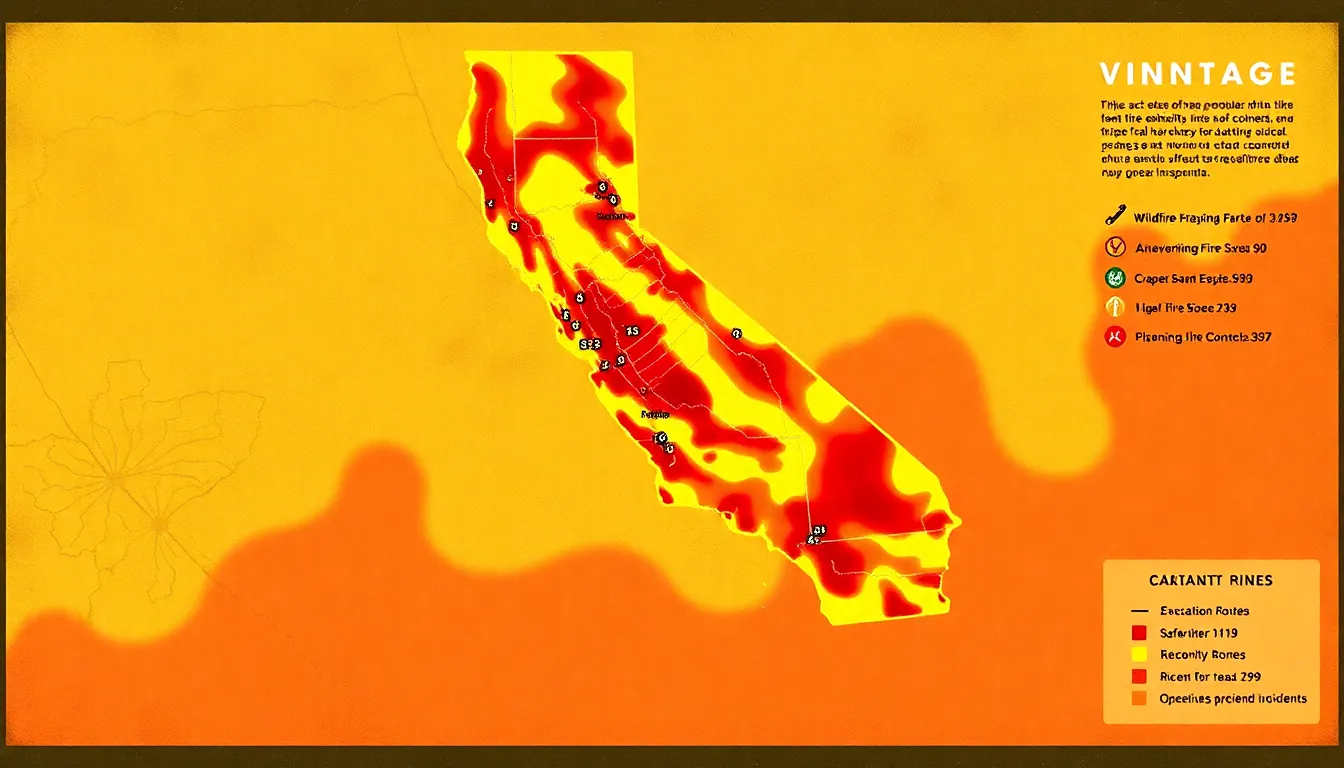California’s wildfires are like that one friend who shows up uninvited every summer—unpredictable and a little too hot to handle. As we look ahead to 2025, understanding the patterns and locations of these fiery intruders becomes crucial. A detailed map of California’s fires not only keeps residents informed but also helps them plan their escape routes and backyard barbecues—because who wants to roast marshmallows while dodging flames?
Table of Contents
ToggleOverview of CA Fires in 2025
California’s wildfires in 2025 present significant threats to communities and ecosystems. Observations indicate an increase in fire activity due to climate conditions and vegetation dryness. The state’s diverse terrain and weather play crucial roles in fire spread and intensity.
Data from the California Department of Forestry and Fire Protection shows that approximately 10,000 wildfires occur annually. These fires consume about 4 million acres, underscoring the state’s vulnerability. In urban areas, fire risks intensify, affecting thousands of homes and businesses.
Many regions, including Southern California and the Sierra Nevada, face high fire hazards in 2025. During peak months, specifically July and August, fire warnings escalate. Residents are encouraged to stay informed through updated maps and alerts.
Technological advancements enhance tracking capabilities in 2025. Drone surveillance offers real-time images of fire progress, assisting firefighting efforts. Satellite imagery aids in predicting potential fire zones.
Community participation significantly impacts fire prevention strategies. Local organizations collaborate with authorities to create fire breaks and manage brush. Educational programs raise awareness of fire safety among residents, reducing risk factors.
Understanding historical fire patterns provides insight into future risks. Past data indicates a correlation between dry seasons and increased fire occurrence. Real-time maps and applications supply vital information, enhancing response strategies for individuals and emergency teams.
Comprehending the causes and locations of California’s wildfires in 2025 remains essential. Current maps serve as vital tools for proactive safety planning. With ongoing support, California communities can better navigate the fire landscape.
Significance of the Map of CA Fires 2025

Understanding the significance of the map of California fires in 2025 enhances safety for communities and ecosystems alike. This vital tool provides detailed insights into fire patterns, risks, and affected areas.
Understanding Fire Patterns
Fire patterns reflect the natural trends regarding wildfire activity. Historical data indicates that certain areas, such as Southern California and the Sierra Nevada, face heightened fire risks during summer months, particularly in July and August. Analyzing past incidents helps in recognizing which regions frequently suffer from wildfires. Real-time mapping tools can track these patterns, enabling quick identification of emerging threats. By understanding these trends, residents and authorities can anticipate potential dangers and take proactive measures to minimize impacts.
Importance for Residents and Authorities
Maps of California fires in 2025 serve as essential resources for residents and authorities. Such maps empower individuals to make informed decisions about evacuation routes and safe zones. Local governments benefit from this data, allowing them to prioritize resource allocation during high-risk periods. Community preparedness relies heavily on accurate information, as it can significantly reduce response times in emergencies. Access to up-to-date fire map data fosters collaboration among residents, local organizations, and firefighting agencies, enhancing overall effectiveness in wildfire management.
How to Access the Map of CA Fires 2025
Residents can access the Map of California Fires 2025 through various online platforms. Websites maintained by the California Department of Forestry and Fire Protection (Cal Fire) provide real-time updates on wildfire activity. Additionally, local government sites offer resources tailored to specific regions.
Mobile applications dedicated to emergency management also feature beneficial mapping tools. These apps deliver alerts and notifications for nearby fire incidents. Users can find downloadable maps that display current fire locations and risk zones.
Interactive fire maps allow for zooming into specific areas. That level of detail helps individuals assess threats to their neighborhoods and nearby ecosystems. Satellite imagery integrated into these maps showcases affected terrains and vegetation health.
Public information systems contribute to accessibility. Many agencies post daily or weekly updates on fire situations and evolving conditions. These resources assist emergency responders in monitoring fire behavior and forecasting potential impacts.
Social media platforms serve as additional channels for accessing fire maps. Following Cal Fire and local news outlets on platforms like Twitter and Facebook provides instant access to alerts and map updates.
Community engagement is vital, as local organizations may convey specific mapping resources available for particular areas. Participating in community forums can reveal additional tools tailored for fire safety and preparedness.
Knowing how to access the Map of California Fires 2025 is key for informed decision-making. Staying updated ensures individuals can act promptly in the face of wildfire threats while prioritizing safety for themselves and their communities.
Key Features of the Map
The map of California fires in 2025 offers crucial functionality to enhance safety and awareness. Users benefit from various interactive features that provide dynamic insights into ongoing wildfire threats.
Interactive Tools and Layers
Interactive tools present detailed layers of fire data, allowing users to customize their views. Users can access information such as fire perimeters, containment lines, and vegetation types. Different layers represent immediate risks, historical fire data, and evacuation routes. Users zoom into specific neighborhoods, identifying threats close to their homes. Geographic information system (GIS) technology underpins these tools, ensuring accurate and real-time updates. This empowers residents and officials to assess their safety proactively.
Reporting and Updates
Regular reporting enhances user awareness through timely updates. Official agencies post real-time information on fire activity and containment efforts. Community members receive alerts via mobile applications and email notifications. Authorities prioritize significant updates, highlighting changes in fire status and potential evacuations. It’s essential for residents to follow authoritative channels for reliable information. Public forums and social media platforms promote further engagement, ensuring everyone stays informed about ongoing situations.
As California approaches 2025 the importance of staying informed about wildfire risks cannot be overstated. Accessing updated fire maps is essential for residents to navigate the dangers posed by these unpredictable blazes. With advanced tools and real-time data residents can make informed decisions that prioritize safety and preparedness.
Community engagement plays a crucial role in wildfire management. By collaborating with local authorities and utilizing the latest technological resources individuals can enhance their understanding of fire patterns and risks. This proactive approach not only protects homes and lives but also fosters resilience in the face of an ever-evolving threat. Staying connected to reliable information sources will empower Californians to face the challenges of wildfires head-on.

